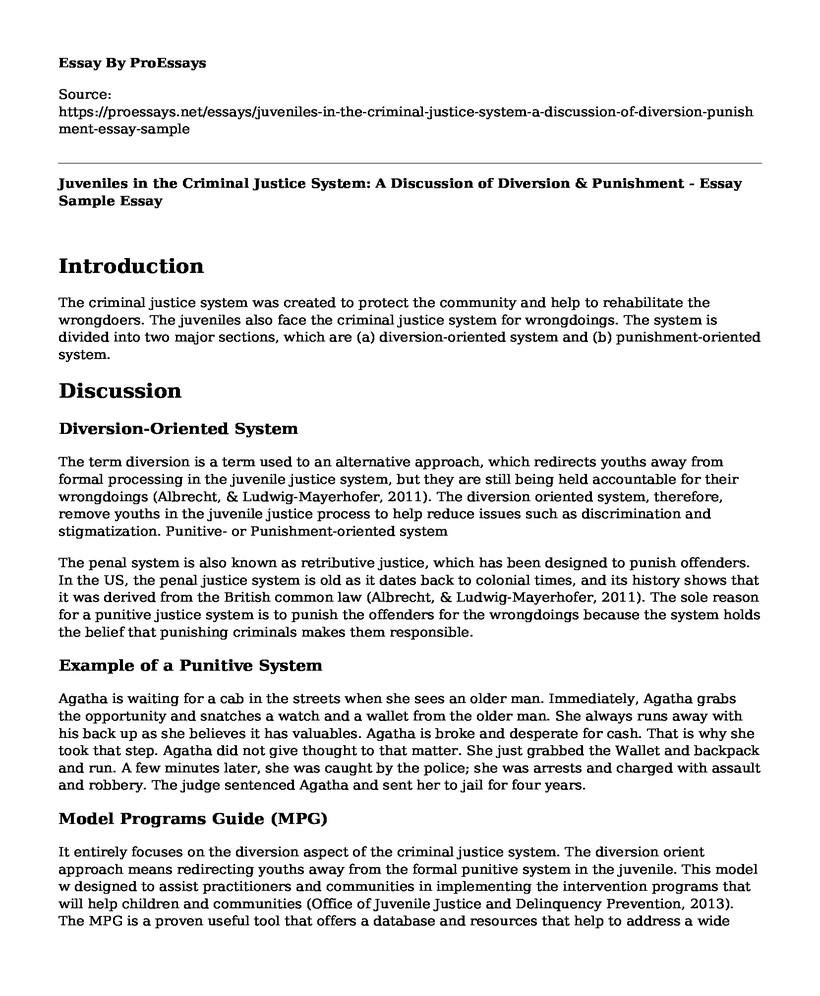Introduction
The criminal justice system was created to protect the community and help to rehabilitate the wrongdoers. The juveniles also face the criminal justice system for wrongdoings. The system is divided into two major sections, which are (a) diversion-oriented system and (b) punishment-oriented system.
Discussion
Diversion-Oriented System
The term diversion is a term used to an alternative approach, which redirects youths away from formal processing in the juvenile justice system, but they are still being held accountable for their wrongdoings (Albrecht, & Ludwig-Mayerhofer, 2011). The diversion oriented system, therefore, remove youths in the juvenile justice process to help reduce issues such as discrimination and stigmatization. Punitive- or Punishment-oriented system
The penal system is also known as retributive justice, which has been designed to punish offenders. In the US, the penal justice system is old as it dates back to colonial times, and its history shows that it was derived from the British common law (Albrecht, & Ludwig-Mayerhofer, 2011). The sole reason for a punitive justice system is to punish the offenders for the wrongdoings because the system holds the belief that punishing criminals makes them responsible.
Example of a Punitive System
Agatha is waiting for a cab in the streets when she sees an older man. Immediately, Agatha grabs the opportunity and snatches a watch and a wallet from the older man. She always runs away with his back up as she believes it has valuables. Agatha is broke and desperate for cash. That is why she took that step. Agatha did not give thought to that matter. She just grabbed the Wallet and backpack and run. A few minutes later, she was caught by the police; she was arrests and charged with assault and robbery. The judge sentenced Agatha and sent her to jail for four years.
Model Programs Guide (MPG)
It entirely focuses on the diversion aspect of the criminal justice system. The diversion orient approach means redirecting youths away from the formal punitive system in the juvenile. This model w designed to assist practitioners and communities in implementing the intervention programs that will help children and communities (Office of Juvenile Justice and Delinquency Prevention, 2013). The MPG is a proven useful tool that offers a database and resources that help to address a wide range of issues such as drug abuse, mental health, and educational programs.
School-Based Diversion Models
Many youths usually come in contact with the criminal justice system every year. Most of the young people are involved with the juvenile system because of minor and non-violent cases. One of the most effective diversion models is the School-based diversion models are designed to help youth who have behavioural disorders issues and divert them into the justice system and help them acquire the needed behaviour. This model has been used in the US, particularly in Ohio and Connecticut. In 2008, McArthur and John did research in which they used the School-Based Diversion Model (Skowyra & Powell, 2006). In Ohio, the School-Based Diversion Model was implemented to help connect youths with any services that will help to decrease arrests and youths taken to juvenile courts (Skowyra & Powell, 2006).
Another model used in the US is The Probation-Intake Diversion Model, whose aim is to identify behavioural health disorders and ensure that young people are diverted before adjudication (Skowyra & Powell, 2006). This program was tested in Texas, and it was determined to be an effective method of helping youths with mental health issues. In Texas, the Probation-Intake Diversion Model was used to train adolescents with mental health, family issues, and motivational interviewing issues.
References
Albrecht, G., & Ludwig-Mayerhofer, W. (Eds.). (2011). Diversion and informal social control (Vol. 17). Walter de Gruyter.
Office of Juvenile Justice and Delinquency Prevention. (2013). Model Programs Guide (Office of Juvenile Justice and Delinquency Prevention).
Skowyra, K., & Powell, S. D. (2006). Juvenile diversion: Programs for justice-involved youth with mental health disorders. Delmar, NY: National Center for Mental Health and Juvenile Justice.
Cite this page
Juveniles in the Criminal Justice System: A Discussion of Diversion & Punishment - Essay Sample. (2023, Mar 24). Retrieved from https://proessays.net/essays/juveniles-in-the-criminal-justice-system-a-discussion-of-diversion-punishment-essay-sample
If you are the original author of this essay and no longer wish to have it published on the ProEssays website, please click below to request its removal:
- Essay Example on White-Collar Crime and Deviance
- Essay Sample on Identity Crime in Social Media Networks
- Expository Essay on Social Justice and Diversity in the US
- Literary Analysis Essay on No Willing Injustice: Edgar Allan Poe & Andre Dubus
- LGBT Human Rights Defenders Criminalized in Caribbean Nations: IACHR - Essay Sample
- Essay Example on U.S. Supreme Court Ignores Film Industry's Artistry Until Oscars
- Free Paper on Maskwacis Crime Crisis: Causes, Interventions, and the Road Ahead







